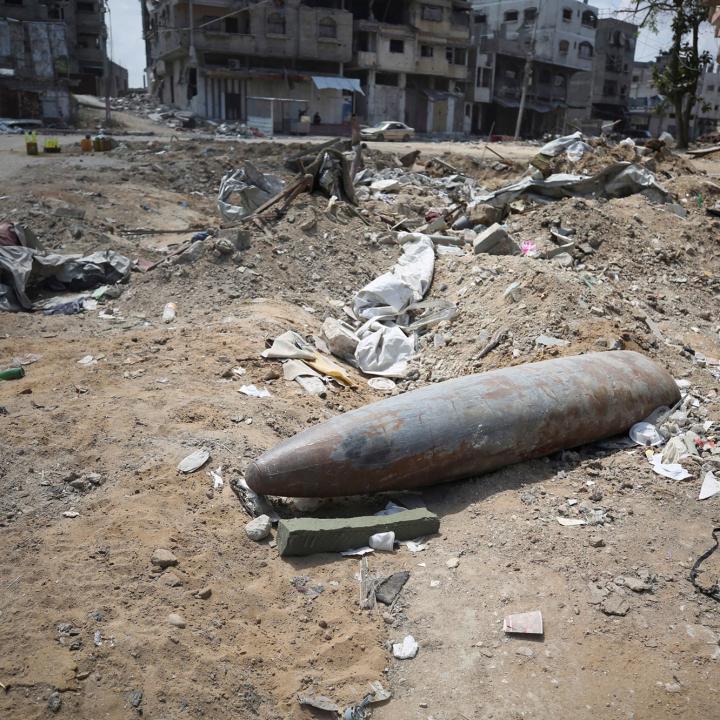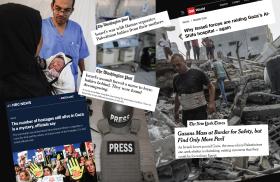
- Policy Analysis
- PolicyWatch 3913
Explosive Remnants: Gaza’s Literal Ticking Bomb

Reconstruction can’t happen until thousands of dud bombs and other explosives are cleared from the urban rubble—a task that faces formidable shortfalls in funding, manpower, and other resources.
Among the many urgent “day after” issues that have yet to be adequately addressed in discussions of Gaza are explosive remnants of war (ERW), a catchall term for “dud” munitions, emplaced mines, abandoned weapons caches, and other explosives left behind during a conflict. These remnants will pose major problems for reconstruction—according to a senior official with the UN Mine Action Service (UNMAS), it could take as long as fourteen years to fully clear Gaza’s rubble because of ERW.
The challenge is twofold: not only can ERW kill, dismember, or blind anyone who stumbles upon them, but they may enable Hamas to reconstitute its military capabilities if the group is able to recover surviving arms caches and unexploded Israeli ordnance. Until they are cleared, displaced persons cannot return to their neighborhoods to rebuild, and the flow of humanitarian aid, agricultural activities, and commerce will be interrupted. Experience also suggests that ERW will cause hundreds, perhaps thousands, more casualties even after combat ceases. Mitigation requires a comprehensive plan to educate the population about ERW, treat resultant injuries, and locate, detect, disarm, and dispose of explosives—all resource-intensive tasks for which there is no technological silver bullet. Thus far, however, no plans have been formalized for interim security in Gaza, let alone for clearing ERW.
Quantifying the Problem
The precise scope of the clearance problem is unknown because the Israel Defense Forces have not disclosed the number, type, and location of munitions they have expended, nor has Hamas disclosed where it has stashed munitions and emplaced devices. As of December, the IDF had reportedly used between 30,000 and 40,000 munitions in Gaza. Even if only half that number were used in the months since then, there could be as many as 6,000-9,000 pieces of unexploded Israeli ordnance in Gaza, assuming a standard failure rate of 10-15 percent. And this may be a substantial undercount given that the above estimates do not include artillery rounds, rockets, or mortars from the current war, nor remnants from previous conflicts.
Moreover, unlike other recent ERW clearance operations in the Middle East (e.g. Yemen, Lebanon), the amount of rubble to deal with in Gaza is immense because the combat zones have been almost exclusively urban. This raises multiple problems:
- In non-urban settings, detection and clearance is conducted to a consistent depth below the surface, allowing for straightforward estimates on costs, resources, and manpower. By comparison, urban rubble varies drastically in depth, and the inherent dangers of accessing damaged facilities make cost/resource estimates very difficult.
- Urban rubble is rife with metallic debris unrelated to ordnance, making metal detectors and ground-penetrating radar nearly ineffective.
- The recovery of human remains will be occurring simultaneously in Gaza neighborhoods, greatly slowing the ERW clearance process.
- Intact portions of Hamas’s vast tunnel network may contain booby traps and additional ERW, requiring even greater caution than normal environments.
Technological Benefits—and Limits
The ongoing urban ERW clearance operation in Mosul, Iraq, illustrates why technological advances will be very helpful in Gaza, but not a silver bullet. New tech has accelerated the clearance of critical infrastructure in Mosul while better protecting personnel responsible for explosive ordnance disposal (EOD). By using 3D imaging and small aerial drones, demining contractors and other authorities have been able to reconnoiter and identify ERW safely and rapidly.
Similar technologies could help in Gaza. Initial remote assessments might be possible in parts of the territory that are relatively secure, assuming funds are available for this task. Clearance teams would need to closely coordinate with the IDF, both to keep their drones from being mistaken for threats and to prevent drone imagery from jeopardizing the security of IDF personnel as combat operations continue elsewhere. These teams would also have to deal with Gaza’s complex, uncharted tunnel networks, which Mosul lacks.
Another rapidly advancing technology—artificial intelligence and machine learning (AI-ML)—currently has little direct applicability to ERW clearance in urban settings. Yet Gaza could provide an important testing ground for this field and a rich source of data for developing algorithms that might revolutionize the clearance process. At present, the use of AI-ML algorithms for drone-based thermal and optical detection of ERW is mostly limited to non-urban settings, but more data might enable safer, faster, and more accurate detection.
For example, a hypothetical AI-ML program could be trained to differentiate the signatures of different types of ordnance and rubble by detecting nuances in magnetometer and ground-penetrating radar data that are unobservable to a human operator. The program could then be enhanced with thermal/optical imagery and targeting data (e.g., location, ordnance type, fuse settings), enabling it to scan imagery for indications of ERW and look for the absence of damage at targets known to have been hit, indicating the presence of unexploded ordnance. Another AI-ML-enabled technology, hyperspectral imaging, could likewise be enhanced by data collection in Gaza and incorporated into a more comprehensive program.
Data, Funding, and Oversight Challenges
Obtaining Israeli targeting data to guide the search for ERW would greatly contribute to clearing efforts. Professional militaries generally record and retain such information, and there is an international legal requirement—Protocol V, Article IV, of the UN Convention on Certain Conventional Weapons—for combatants to provide records on the use of explosive ordnance to facilitate clearance. It is far from certain, however, that combatants consistently provide this data to the UN.
For example, according to annual reports submitted to the UN Office for Disarmament Affairs, the United States has “to the maximum extent possible track[ed] and record[ed] every use by U.S. military forces of explosive ordnance” since becoming a signatory to the convention. Yet it is not clear that this information has been available to the UN or used by third-party demining entities.
Israel is not a signatory to Protocol V, though it should consider providing its targeting data as part of its support to Gaza recovery and stabilization efforts. Moreover, assurances should be given that if Israel chooses to provide such information, it will not be passed on to entities that might use the data to harm Israeli interests. Officials might also consider turning the country’s robust AI industry toward the ERW detection problem, with the IDF providing detailed data for Israeli firms to train their AI systems on. After all, Israel has a vested interest in humanitarian demining entities recovering ERW before armed groups in Gaza do.
ERW clearance efforts in Gaza will run into funding shortfalls as well. In 2023, UNMAS managed twenty demining programs around the world (including in the Palestinian territories), and many were underfunded. In Iraq and Syria alone, the agency estimated a cumulative $35 million shortfall. In the Palestinian territories, the budget for UNMAS demining operations in recent years has ranged from $1.5 million to a high of $5 million—far short of the estimated $40-$50 million that will be needed annually just for Gaza ERW clearance.
Israel and the international community must prepare to share this financial burden. Similar to U.S.-funded ERW clearance efforts in Southeast Asia and Iraq (which have cost $885 million and $716 million, respectively, since 1993), Israel should fund some of the upcoming effort in Gaza. This is becoming a post-conflict norm for Western democratic militaries, and doing so will enhance Israel’s security. Arab nations could also provide funding and, perhaps, some technical expertise—for instance, Saudi Arabia has led the Project Masam demining program in Yemen since 2018 at a cost of roughly $30 million per year. Going forward, the Gulf states could commit to funding this essential aspect of Gaza reconstruction through UNMAS or another international entity.
Regarding the question of who will oversee and execute ERW clearance in Gaza, there are generally four options for such programs: military EOD teams, contractors, humanitarian organizations, or trained locals. The Palestinian Authority runs a very small mine action center (PMAC) that has mainly focused on clearing minefields in the West Bank; its EOD unit is tiny and poorly equipped. Accordingly, UNMAS or a suitable NGO, funded by the United States and other Western donors, would have to supervise the demining effort in Gaza until PMAC can be suitably expanded and trained.
As for doing the actual clearance work, developing a large, capable cadre of Palestinian demining and EOD personnel is essential in the long term—but impractical in the short term. Training such experts is time consuming, and Israel may fear that Palestinian deminers could provide recovered explosives to hostile actors. In the United States, military EOD units are generally prohibited from humanitarian ERW clearance by law. Other Western militaries will be similarly hesitant to commit their EOD forces, which are widely seen as a high-demand, low-density asset. Although some East European and Asian militaries might consider sending EOD units to Gaza to boost their prestige and training, the equipment required for clearing large amounts of urban rubble exceeds the capacity of most any force worldwide.
In the end, contractors and humanitarian organizations will have to conduct most, if not all, ERW clearance in Gaza, as in Mosul. Yet without IDF security guarantees, a clear Hamas commitment not to target these organizations, or both, very little can be done. While combat is ongoing, UNMAS should work with various Israeli entities—the Unit for the Coordination of Government Activities in the Territories (COGAT), the IDF’s EOD teams, and the Israeli National Mine Action Authority—to start locating and recording areas of particular ERW concern and clearing immediate hazards to allow for the safe transit of humanitarian aid and restoration of critical services. By identifying zones with adequate security and providing targeting data, the IDF and COGAT could empower contractors or NGOs to begin locating, surveying, and quantifying ERW, thereby informing future reconstruction decisions. Yet this effort would be much more effective if guided by a central mine action coordination center.
Conclusion
The ERW problem in Gaza is immense—there is no easy way to facilitate clearance and reconstruction in a largely destroyed urban landscape with dangers above and below ground. Several measures can ease the challenge somewhat, such as continuing to avoid the use of IDF cluster munitions, employing drones to reconnoiter ERW hotspots, embracing the principles outlined in Protocol V, and urgently raising and earmarking funds for ERW clearance. Creative application of technology and data collection will prove beneficial as well, particularly for future conflicts.
Yet clearance efforts in Gaza cannot be truly effective unless they are nested in a larger program of stabilization and reconstruction. And they will essentially be on hold until there is either adequate security or a long-term ceasefire. Over the many years it will take to clear ERW from the war-torn territory, some authority will need to marshal limited demining resources, make tough prioritization decisions about where these resources are used, and provide security for the personnel carrying out this arduous but lifesaving work.
Col. Andrew Clemmensen (USAF) was a 2023-24 military fellow at The Washington Institute. The conclusions and opinions expressed in this article do not necessarily reflect the official policy or position of the U.S. government, the Department of Defense, the U.S. Air Force, or Air University.



